|
Feature
July 4, 2006
Sacha’s First Mission
A Strategy First: Project One Fighters Gold Mission Report
by Cat
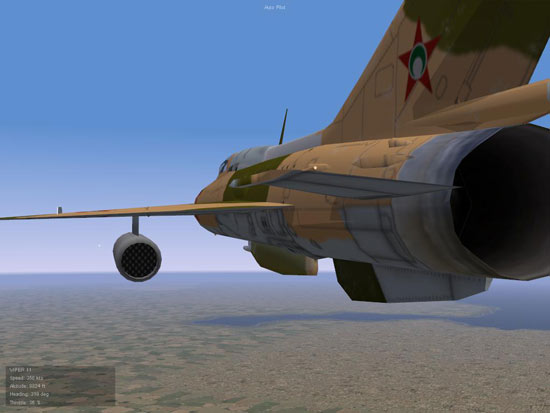
I know, I know, my brothers and sisters. It is been too long since I spoke to you, eh? It has been most busy here in the Emirate of Abkhazia. As you have seen, we are still fighting the Sheikh, and when I last spoke to you things were really beginning to get hot! The war in Iran that the American Navy and Marines are fighting still is going on, and when we last spoke (and you will see the story again in this space, I am told), the Jolly Rogers had struck again, and I was on my way to Bahrain for an inquiry by the American air force into the tanker incident some months ago, where I nearly had to shoot down a Hornet of their navy. My friend Captain Bones tells that story far better than I could, and you may find it in his posts on the forum for the Hornet fighters here in this place. I have had some small part in their struggle, because the Sheikh, he is a student of the Iranian ayatollah. But that story will wait for another time.
It has come to my mind that many of you do not know how I got my start in this, our shared business. It is true that my father is highly placed in our VVS, though I do not like to rely upon him, still, do not think that I have not taken advantage of that from time to time! It is how I have gained such a wide range of flying experiences. But things were not always so. Once I was what you would call a “rookie,” da? And like any new pilot, I had my very first combat mission.
In 1995, I was a new graduate of the test pilot school at Saki, and six of us were posted to our advisors unit in the Emirate of Paran, to complete our training with actual combat experience in their ongoing War of Attrition with the Dhimar Republic. Is it not strange that twelve years ago, I fought with one Emir, and today, I fight against another? But the Emir of Paran is a most kindly, older gentleman, not like Muqtadeh, who would gladly kill until all our streets ran red with blood. Today, Dhimar and Paran are in an uneasy truce, with a United Nations intervention force guarding their fractious border, and our advisors, along with the NATO advisors to the Dhimari air force, are keeping a much lower profile. What with this War on Terror in Abkhazia, and Chechnya, and Iran, and Iraq, the United States and we are allies-if not always happy ones. We do not want to fight one another, for we have a common enemy, the evil ones like Muqtadeh, curse him. In 1995, though, Russia had lost the glorious Soviet Union, and then as now, we did not wish to accept a lesser status in the world. Paran was our ally, and we continued to help them as we could. Paran and Dhimar were fighting skirmish after skirmish on their border, though neither wanted full scale fighting. It has been going on over there for decades, this dirty little secret war. When it flares up, as it does from time to time, it is almost entirely an air war and special operations war. A war of dirty tricks. I am not proud to have played my part in that, but we are soldiers and must follow orders, no?
The leader of our group was Major Ivan Raskov. This is not the first time I would cross paths with Grandmama’s old unit from the Great Patriotic War. Major Raskov is descended from the family of Marina Raskova, who recruited Grandmama from dusting crops in the kolkhoz in 1940 into the 586th IAP, the first all-women pursuit squadron, and my current assignment, though of course it is no longer all-female. At Saki, we were introduced to Raskov, and to an old stand-by in Soviet military aviation, the MiG-21. Many of our aviation cadets still learn in MiG-21 aircraft, before graduating to modern fighters like the MiG-29 and Su-27. My father flew the Twenty One for many years and more than any other jet, this is the one I associate him with. One of my favorite books as a child, strangely enough, was an operations manual for the very variant I would fly in combat for the very first time, nearly twenty years later.
The Parani air force is a mix of old Cold War aircraft, mostly Soviet built. Three types of MiG-21, including the F-13, the PFM, and the MF variants fly to this day for Paran, along with the old MiG-17 and MiG-23. Oil wealth keeps them well maintained, and their pilots well trained. On the other side of the border, an eclectic mix of Phantom and Mirage fighters, along with A-4 Skyhawks and ancient F-100 Super Sabres, make up the Dhimar king’s air forces. A trip to this little island is a trip back in time, for any combat aviation buff. Parani air cadets learn on the F-13 MiG, and graduate to the PFM and MF variants. Their best interceptor pilots fly the MiG-23, and the MiG-17 and Su-7 are used for ground attack.
This day would be my first test. I remember it well. Paran’s D7 airfield is nondescript. Many of their front-line facilities are little more than unpaved, bulldozed encampments with a runway of packed dirt, maintained by bulldozer and road grader. There, the Parani 4th Fighter-Interceptor Squadron maintains its position, facing down their enemies across the border. They are equipped with the MiG-21 PFM, an old, old front-line fighter first coming into service in 1964, years before my father Dmitri Petrovich even met my mother! He tells me of when the PFM was superceded by MiG-21bis and MF fighters in the early 1970s; truly, by 1975 the PFM had been consigned to the scrap yard in all but the Third World! The first time I was confronted by one of these veterans, the look on my face must have been priceless. I remember telling the Major that its place was in a museum, not a front-line airbase!
Major Raskov laughed at that, saying “Ah, Sacha, that old warhorse has plenty of life in him yet. You will see!”
I had trained at the Academy on MiG-21bis and MF aircraft and so the transition took only a day or two. My first solo flight was in a Twenty One, after all! As I said, I knew the manual well from my childhood and truly, this 45 Red I was partnered with quickly became a trusted friend. One does not forget her first love so easily, does one? He was built in 1968 at Znamia Truda in Moscow, when my father was fighting in Vietnam with my current commander. I was still not even what you would call a gleam in my father’s eye yet! Much like American B-52 pilots have found, the airplane is far older, and perhaps wiser, than I. Once we were all up to speed, the acid test. I volunteered for the first mission, a strike on a Dhimari electric generator outside the capital. This was to be the latest in a long list of reprisals for a Dhimari strike on a Parani airbase complex south of our base.
Mornings on this isolated little island are often cold, and this was no exception. A biting chill in even deepest summer is routine in the Paran desert, but by noon it can be blazing hot, over 40 degrees! Of course, that is Celsius measure, I forget that some of you still use English units of measurement. Major Raskov was cheerful as we all took breakfast with the Parani pilots, and we relaxed with coffee as they went to their morning prayers, the six of us discussing the upcoming mission. Once the morning service concluded, we all met in the Operations hut for the briefing.
Go
To Page 2
Feature: Sacha's First Mission
Back To Page 1
“The generator is in a large building on the north side of the capital.” The Major pointed at a spot on the projected aerial photo. “As you can see, it is in an open area. Here, we may strike with the least chance of civilian casualties. This plant services the north side of the city and it will be in darkness once we strike.”
My Academy classmate Iosef spoke up. “But sir, I thought we were confining strikes to military targets. Is this not a civilian target?”
“Nyet.” Raskov smiled, wolfishly. “At least, not precisely. The main reason we strike here is that the southern command center receives its power supply here. This is a reminder to the Dhimar king not to hide his military assets behind a civilian shield. His people, after being in darkness for awhile, will remind him more forcefully than we can with one strike on a building not to do that again! It is the very lesson that the Emir was forced to swallow three weeks ago, when he placed MiG fighters in a civilian airfield, the international airport, which the Dhimaris then promptly attacked with Mirage fighters. The Emir wishes to send a message: What is sauce for the goose, is sauce for the gander as well!”
I take careful notes on my NPL whiteboard, which will be strapped to my left leg in the aircraft for reference. It has three pages for information storage and a wheel to calculate navigation and fuel usage. The landmark is a large, blue and white mosque on the outskirts of the capital. It is near to the plant, and under no circumstances may we strike it. One thing about the Dhimaris and the Paranis is that they thankfully are not very good at ground defense. Aside from a few guns and old SAMs, that is. Most of these are clustered around military bases, which this target is not. We will not receive much in the way of resistance. Raskov decrees the armament for our trip. For me, B-8 high-explosive rockets. For him, FAB-250 bombs. The MiG is tiny, carrying less than 3000 kg of fuel, and so its warload is light. I carry two rocket pods, he has two bombs. My mission is to create confusion and disperse any Dhimari soldiers with Redeye or Stinger missiles. Raskov will follow me in and drop his bombs before the enemy can gather its strength. Our call sign today is Viper 549, and we hope to strike as fast as the snake whose name we carry.
In our locker room, I suit up. It is early in my career, and the mishmash of American and Russian gear I wear today, I did not have then, of course. On my wrist I then wore a Poljot “Ocean” chronometer, to time legs of the flight. We depend greatly on the clock in the aircraft dashboard for such things as well, and especially for timing flight of air to air missiles. I will not be carrying any air to air armament, though, because the Twenty-One only has two hardpoints and they will be taken up with rocket pods. If we get into a scrap with Dhimari fighters, the 23mm gun pod will have to do. I have first my blue VK-3M ventilation suit. In our planes, we can plug into the air ventilation system for assistance in maintaining body temperature. The VK suit, made by Vympel, allows me to be comfortable in temperatures from –50 degrees C to +50 degrees C! Over it I wear my camouflage jumpsuit, and my “speed jeans,” the PPK-1U partial pressure suit. This is all very different from the VKK-15 gear I wear today. My IPK harness for the ejection seat goes over my flight suit, and I have my ASP-74 flotation belt on and my NAZ survival kit, and of course my Makarov pistol in its shoulder harness. Over my head I wear a ShL-78 leather helmet underneath a white ZSh-3M hard shell helmet with visor, and a KM-32 oxygen mask Tough leather boots on my feet. Today, I wear much lighter “Hi Tec” boots that I procured from the Americans. So much gear we carry!
In the hangar, my Parani crew chief helps me up the ladder and into the cockpit. They are still amazed that we have women who fly fighters. One of the early problems when VVS women came to Paran earlier was the clash of cultures. We had to be most careful not to offend their religious sensibilities. Things are better now, but still it can be tense. The cockpit in the Twenty One is very cramped and close-fitting. My father says that one does not climb into the MiG; rather, one puts it on like a pair of tight American blue-jeans. This is an apt analogy. The PFM’s canopy is side-hinging, and the Parani crew slams it into place, locking it down. I am on ground power. I complete plugging my “speed jeans” and my ventilation suit into the aircraft systems as the APU whines, giving me electrical power.
It smells of old rubber insulation, mold, kerosene, and sweat. I can smell it even through my KM-32 mask. How many pilots have been here before me? What have they seen? What fears have they faced? What challenges have they overcome? I resolve not to disgrace their memories, and punch the starter. The single R-11F2S-300 engine screams to life behind me. This old warrior is still capable of twice the speed of sound, and is light, fast, and maneuverable. He can still fight. I am on internal power, and the crew disconnect the APU, one standing before me with hands upraised, his swarthy face half-shadowed in the morning light slanting across the revetment door. My ground-guide, motioning me to the taxiway.
As I slowly exit the revetment, to my right I see Red 46, Raskov’s aircraft. Do not let the scruffy look of the beat-up and patchy, faded Parani camouflage fool you. Under the ancient armor, these MiGs are as good as new. We will show the King of Dhimar something today.
“Viper 2, take position ahead of me.” Raskov is waving me ahead of him, where he can watch his pupil closely. I taxi cautiously out, as he calls the tower operator to announce that Viper flight is on the air and requesting taxi clearance.
“Viper 549 flight of two, taxi to Runway 18 and hold.”
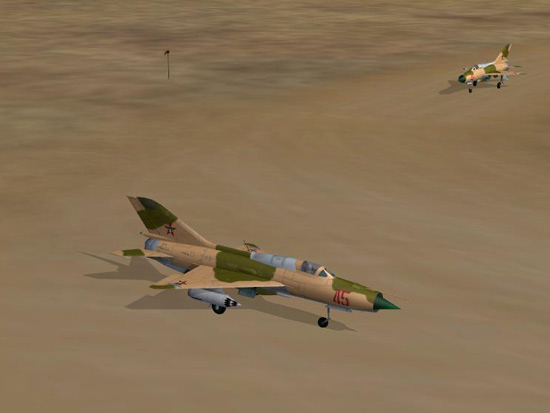
It is easy, because there is only one loop taxiway and one runway, known as 36 or 18, at the D7 airfield. We taxi out and I pause at the marker before turning onto the strip. We know no one is landing, but one must be sure. It is early on a Friday morning. This is their holy day. They will not be expecting us to fly.
“Viper 2 ready to go, holding at Runway 18.” I am trying not to let my voice crack. I have never been so tense in my life. It all comes down to this, and if I am too slow, or too inattentive, one bullet will end my career and take my life. All this and for nothing? I resolve to concentrate all the harder- this is for the Rodina, and I must not fail.
“Viper 2, position and hold. Viper leader, hold at the marker.”
I swallow the lump in my throat and wheel 45 Red onto the runway. He is smooth under my hands, an old stallion who knows his business.
“Viper 2, clear to take off. Viper leader, position and hold after Viper 2 departs.”
It is time. I grasp the throttle and take a deep breath to settle my nerves.
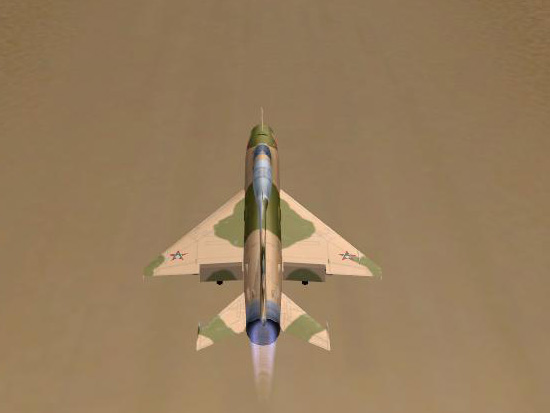
Go
To Page 3
Feature: Sacha's First Mission
Back To Page 2
“Hit it, Sacha! It’s time to go to work!” Raskov is confident, projecting calm, the voice of experience. Obeying, I firewall the throttle, and 45 Red leaps forward! Nothing accelerates like a MiG-21 in full reheat, even today. Fighters now are much larger and heavier, and though they are as maneuverable and sometimes, even faster, they do not have that instantaneous power that the Twenty One has!
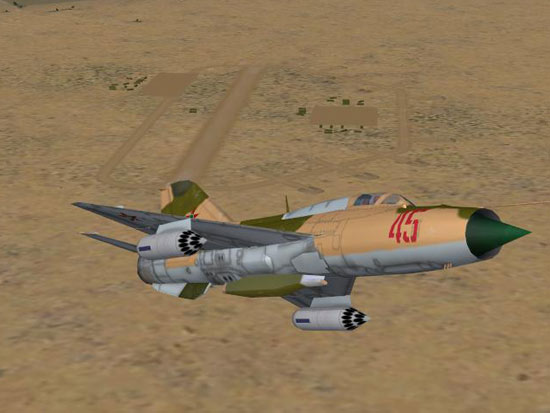
Only in flying the F-16 at your Nellis Air Force Base did I have that same exhilarating feeling that I myself was flying, that the Twenty One conveys to its pilots. My American friend “Sugar” Deitz would say ‘what a rush!’ 45 Red literally claws for the sky, its desire to be in its element almost palpable. Though its range is only about 1100 kilometers, its flight performance is in many ways comparable to today’s fighters, and the Israeli conversions of the MiG-21 PFM and –bis to MiG-21-2000 and “Lancer” configurations, along with MiG’s own 21/93, are proof that the design yet has life.
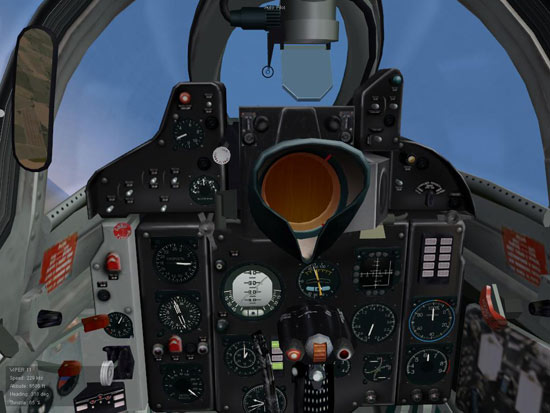
And our target is just over the border. We will have fuel to spare.

I switch my RP-21 radar on, and set it to stand by, no emissions. The RP-21 is like a flashlight in a dark room-its beam extends forward from the jet, and moves up and down with the nose. There is no raster-bar search like our modern aircraft have, and the MiG consequently does not have look-down/shoot down capability. It is short-ranged as well. Better to rely on GCI, because if we must fight another aircraft it will be at gun range if their missiles do not get us first.

Go
To Page 4
Feature: Sacha's First Mission
Back To Page 3
“Viper lead is airborne.” Raskov is with me, closing from behind as I acknowledge the tower’s instruction to turn onto the base leg of my course to the Dhimar border and resume internal navigation. The day is going to be cloudless, beautiful under a cerulean, crystal expanse. Below us, the tilled fields of the Paran landscape begin unfolding, their greens and browns identical to the weathered camouflage peeling from the exterior surfaces of our jets.
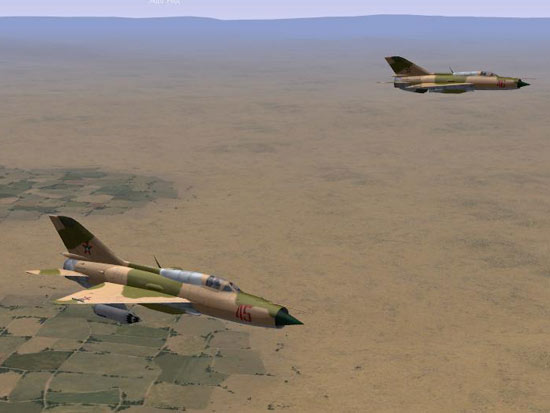
We rise to 10,000 feet, and settle on course for the thirty minute flight. Soon, the ground controllers pick us up and Raskov orders us to squawk our IFF to their requested settings.

I can see the coast ahead and to our left. We’re approaching what Western pilots would call “Indian Country.” In other words, the land of our enemies. Apropos, because Indian air force pilots are among the U.N. forces across the border.
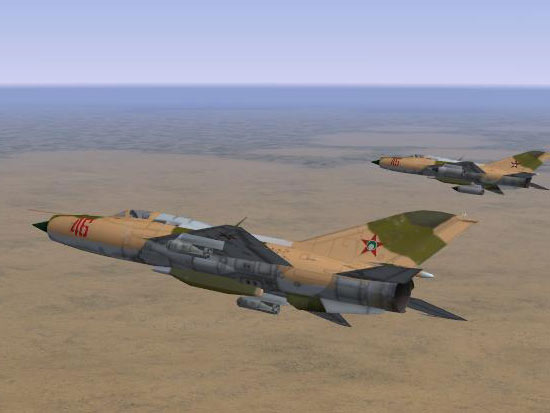
So far, GCI has no hint of enemy aircraft, but it is only a matter of time. We know that Argentine A-4 “Caza” and Belgian Mirage-5 aircraft are based near the border and a response is almost certain once we cross it. If we are intercepted, we will turn back rather than chance a confrontation with U.N. or NATO forces. We will only fight if fired on.
“Viper flight, fifteen to IP. Complete fence check now.” Raskov, reminding me that we’re about to cross the border. I reply. “Viper 2. Nose cold. Fuel 2000. Stores check. Lights off. IFF active.”
We’re crossing the border. My Sirena warning system is set for enemy tracking radars and I have heard nothing from it. The Sirena is audio only, unlike the Beryoza with which we are all now so familiar. Have we caught them sleeping?
Go
To Page 5
Feature: Sacha's First Mission
Back To Page 4
“Look at that! Right over one of their airbases and they’re sound asleep!” We are passing over a Dhimari airbase, it’s sliding under my right wing! I later found out that Parani commandos struck the largest radar station in the Dhimar air defense warning system in this area prior to our flight, but right then I could only stare out the canopy in wonder. Just any other training flight, right over an enemy airfield. They do not know we are the enemy… I consider for a moment, recalling that Indian MiG-21 aircraft are also flying with the Dhimar forces in this area. They must think we’re the Indians! They are in for a nasty surprise.
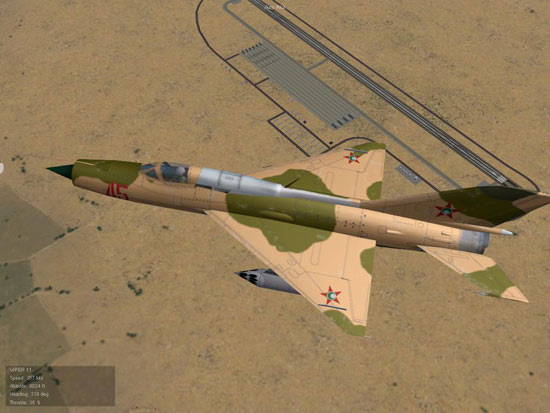
“Back to reality. IP in five minutes. Weapons hot.” Raskov refocuses my attention as we turn onto course for the initial point. I concentrate, trying to remember the aerial photos. The generator building is at the northeastern edge of the city. Raskov’s voice on the net is soothing, calming, as he calls the tactical control center to verify that the enemy has not scrambled to meet us.
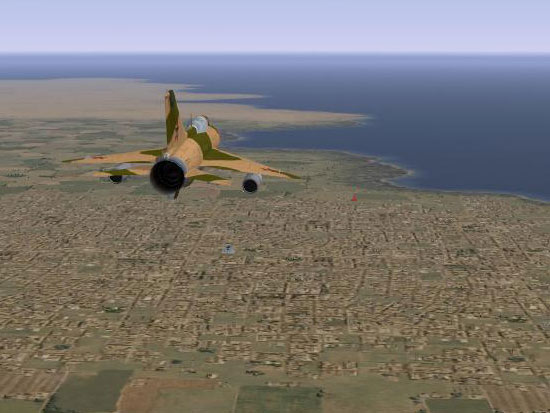
“Two, IP.” I am concentrating on the task at hand now, and suddenly, I feel calm, my nerves gone. Slipping under my left wing, the landmark! I push up my visor, scrabbling in the bag jammed down beside my seat for my binoculars.
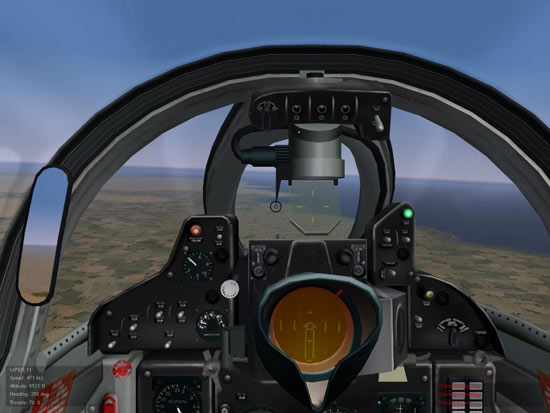
Yes, there it is, the generator! “Target in sight, in hot!” I snap inverted and pull my nose onto target, lining up the metal gun/rocket sight.
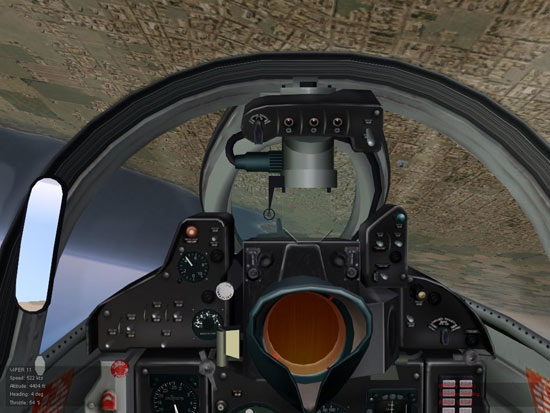
Go
To Page 6
Feature: Sacha's First Mission
Back To Page 5
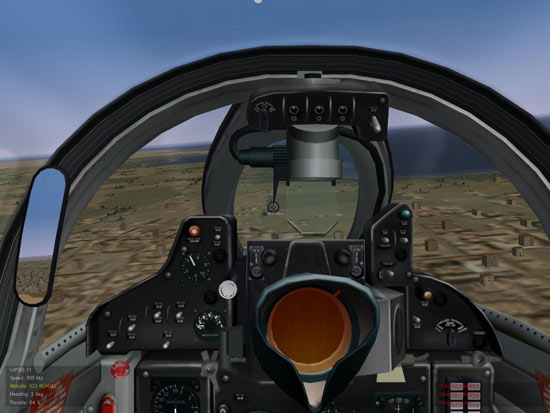
“One pass, two. Hose it with your rockets and I’ll drop the bombs. In and out, fast and smart.”
I acknowledge the call and steady my wings. Coming into range I let fly with rockets, measuring them carefully. My speed is about 400 knots and the target comes up fast, I release about half my load and swoop down through the dust cloud kicked up by the explosions.

“Two, off to the northeast!”

“You’re short!” Raskov snaps. “Pull your nose higher on your next pass! Remember, B-8 rockets have a very short range and you must be right on top of the target before you shoot!” Raskov is lining up for the bomb run. “One’s in hot. Once I pass, two, give me a damage assessment, then set up for a final run with any remaining rockets.”
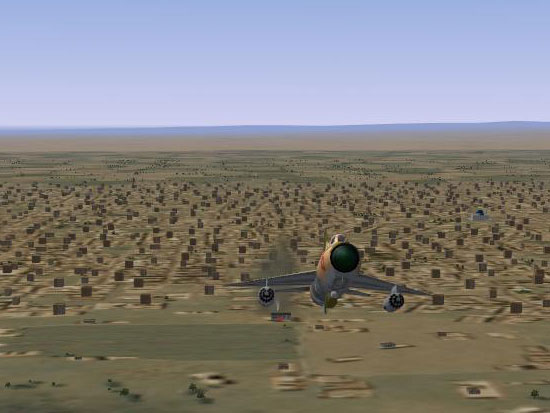
Go
To Page 7
Feature: Sacha's First Mission
Back To Page 6
Raskov is an expert at this, but sometimes even the best do not get the results they want. From my position orbiting high above him, I can see that his approach is textbook perfect. But bombing with iron sights in an aircraft designed for air interception is dicey at best!
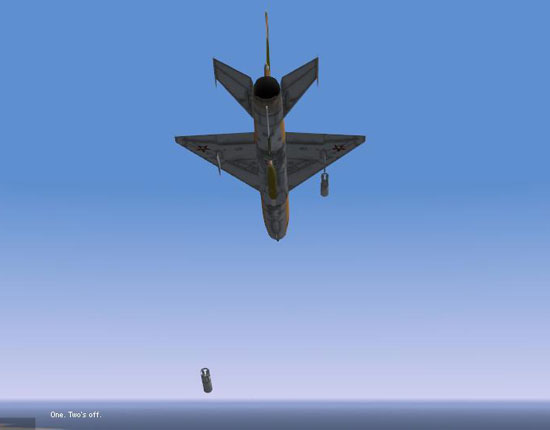
The FAB-250 bombs drop loose, first one, then the other, spaced to give a higher chance of a hit. But like mine, Raskov’s effort falls short. I call it in to him, and he is not pleased.

“Two, you need to make this pass pay off. We cannot chance another. Our fuel will run low and if we loiter here, we invite interception. Make your run from the north, and whatever happens, head for the egress point!”
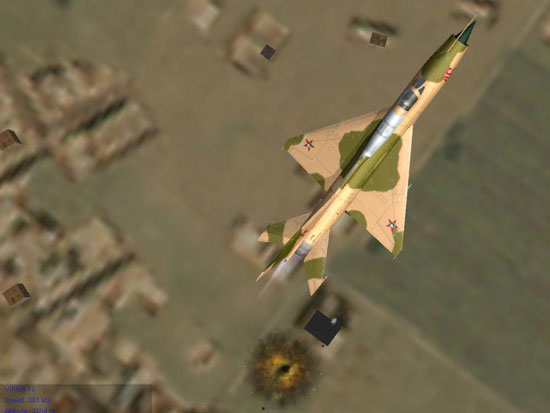
I am determined to get it right this time. We must not fail! I roll in again and this time aim just over the target with my iron sight.
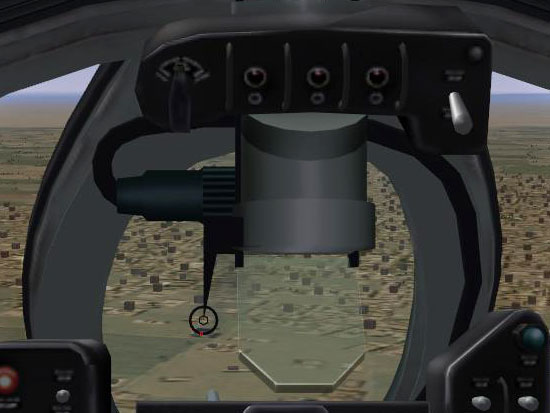
Go
To Page 8
Feature: Sacha's First Mission
Back To Page 7
Coming into range, I squeeze off rockets but they’re falling short still!
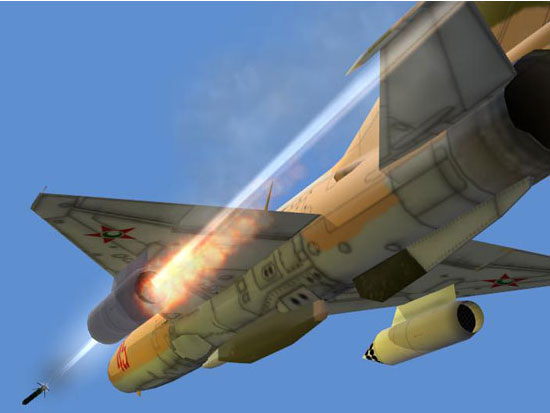

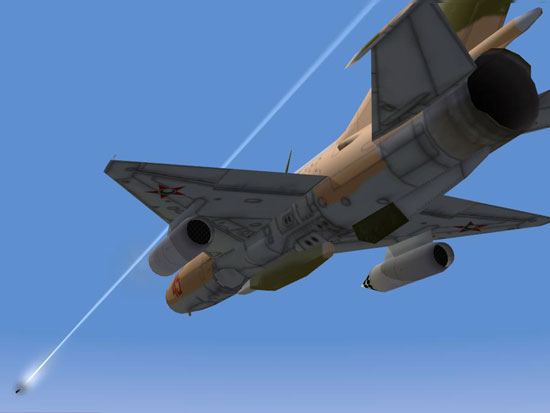
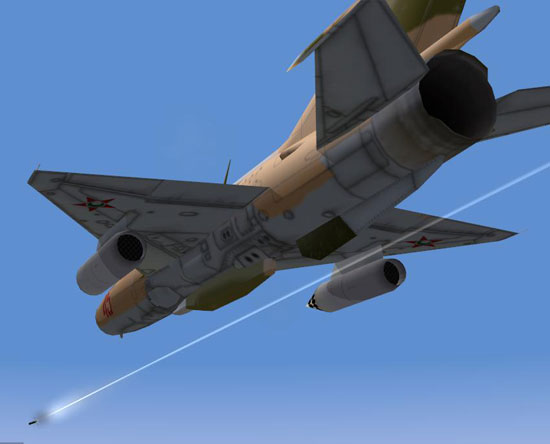
Go
To Page 9
Feature: Sacha's First Mission
Back To Page 8
“Sacha, close in before you shoot!”
I take a breath and wait till the building seems to fill my windscreen!

I will crash if I do not pull up quickly! I fire, more rockets blazing out of the launcher! I pull out of the dive only sixty feet above the ground, as fire and smoke fly and shock waves from secondary explosions buffet the MiG. I hear an exuberant whoop in my headphones.

“Shack! That’s a kill! Two, egress to the southeast, now!”
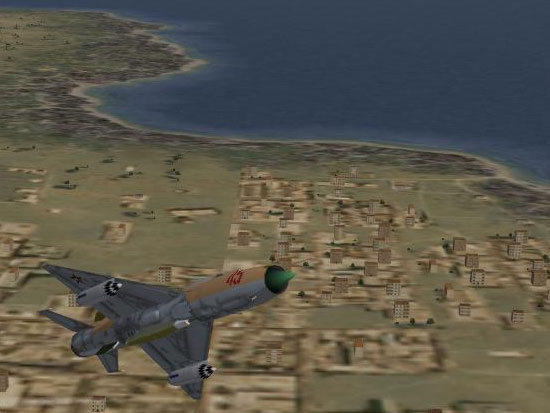
I’m breathing heavily, the adrenalin still coursing through my veins. “Two’s off to the southeast!” I look up, where the rear-view mirror is in the MiG, set into a coaming in the top of the canopy. Behind me I can see the blazing hulk of the generator building.
Above me, Raskov’s MiG dances through the sky, looking for its place at my wing.

Go
To Page 10
Feature: Sacha's First Mission
Back To Page 9
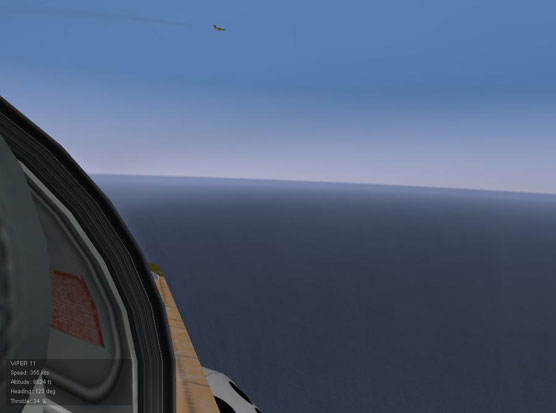
The flight home was as uneventful as the trip to target. We never did find out why the U.N. forces did not respond to our sortie, and I am glad we did not face them in the air that day.

There have been many missions for me since that day. From Paran, I went to our advisory group in Ethiopia, and from there, to the test group at Saki, and I was an exchange pilot to the American Air Force later. Before Abkhazia, I flew support missions in Chechnya, and I trained with the Moscow PVO. Years later, I received designation as sniper pilot, the best of our pilots, much like your Top Gun naval aviators.
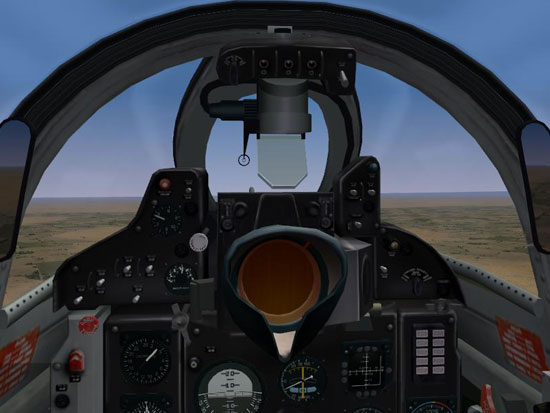
I have flown many aircraft. But one never forgets one’s first love. I learned the MiG-21 at my father’s knee. Like him, I flew one in combat, though only a very few times. But I will never forget the aircraft, those I flew with in Paran, or those who trained me so well.
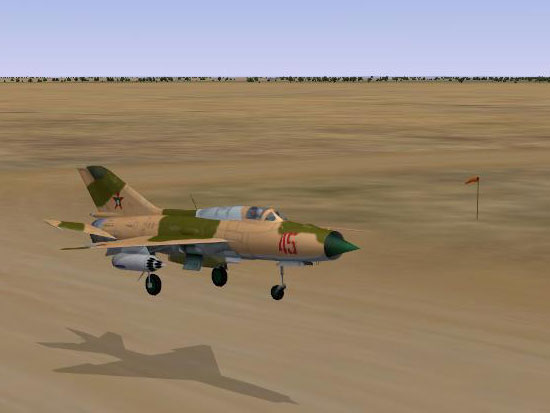
System Specs
- AMD Athlon 3000+ processor
- MachSpeed N2PAP-Lite motherboard
with onboard Aureal AC97 sound
- NVIDIA GeForce 6800GT
- 1GB Kingston PC2700 DDR DRAM
- Creative 12x CD-ROM
- Maxtor 40GB main drive
- DirectX Version 9.0c
- Windows XP Home with SP2
We
want your Feedback. Please let us know what you thought of
this article here.
Click
here to go to top of this page.
Copyright 2008, SimHQ.com. All Rights Reserved. Contact the webmaster. |

